As they dismantle the stones, roof, and interior of the former St. Agatha Roman Catholic Church, the demolition crew is taking apart memories, history, art, and part of a community’s fabric, to be replaced by a nondescript pharmacy in Ellwood City, Pennsylvania. At the corner of Spring Avenue and Fifth Street in the downtown, the CVS Pharmacy will be right across from another national-chain drugstore. The demolition company isn’t to blame. It’s doing the work of a large corporation. But if stones could wail, these surely would.
During this past week, a crew using a jackhammer, aerial boom, and other equipment has been taking down a structure that a congregation built nearly a century ago and dedicated in 1918. Italian immigrant stonemasons shaped the stones of the building and an outdoor grotto.
It’s one place in a town of 7,740 residents in Western Pennsylvania, hundreds of miles away from dozens of properties in New York City that have been facing their becoming vulnerable to the same fate – including a church in the Bronx; a cemetery that dates back more than 250 years in Staten Island; the monumental building on Manhattan’s West Side that first powered the New York City subway in its first days; and an 18th century farmhouse in Gravesend, Brooklyn. Earlier this week, the New York City Landmarks Preservation Commission (LPC) considered a backlog of 95 sites, prioritized 30 of them for historic landmark designation, and took most of them off its calendar without judging the merits. (Mindfulwalker.com plans to follow up on the ramifications of the LPC’s decisions in a separate post soon.) They had been on the LPC’s backlog list for years, 85 percent for more than two decades while the commission considered other places for designation.
The historic and beautiful church building in a Western Pennsylvania town and dozens of places in a city of 8 million are connected by meaning, memory, significance, and art. Once someone razes them, they’re lost forever to a neighborhood and city or town, alive only in recollections, historical documents, and images. On a day when I was researching about the New York City hearing, I saw a photo of St. Agatha’s that an Ellwood City resident had taken when the crew had ripped off part of the bell tower, leaving a jagged edge on the tower. It set off a feeling of deep mournfulness.
Since then, as I’ve learned, I’m far from alone in that mourning for a place that is disappearing in my home area. It doesn’t mean that every older building should be saved, but many people know intuitively, quite deeply, and, most of the time, correctly when some interests in society have gone too far in destroying what should be saved and allowed to live on. In the face of huge commercial interests, such as a national drugstore chain, citizens can feel powerless. Still, they know, in their minds and souls, that an incalculable loss is taking place.
When someone tears down a historic site like the former St. Agatha’s, which the Pittsburgh Diocese closed in 2007, it rips a hole in the community and takes something from those whose lives have been intertwined with this place. As St. Agatha’s comes down, people have come to bear witness to its destruction, taking many pictures. They and others who couldn’t be there have expressed intense feelings – horror, sadness, anger, confusion – and have written online of their memories, in great detail.
St. Agatha’s Church building, on Feb. 1, before demolition had begun
A photo shows the structure on Feb. 23, four days after the work crew started to raze the building.
Photo Credit: Mark Barnes
The pictures of the crew taking apart the structure bit by bit – light suddenly showing through fragments of walls, chunks gouged out of the roof, and open holes where arched window frames once held stained glass, have sparked an outpouring. A local resident photographed the crew’s first removal of huge pieces from the exterior and shared the photos on a community Facebook page for Ellwood City. This first posting of the pictures (which was followed by others) drew dozens of heartfelt comments, and people shared the first post 44 times.
”Hurting Terribly”
For many former church members, the loss is painful. “The time to save it is gone…is correct,” one wrote in response to another, “but for those of us who went to that church, we are hurting terribly.” It’s very similar to the death of a loved one, she concluded. A woman who was part of the church for many years, wrote, “I am upset that they tear it down to put up a drugstore on what I believe to be sacred ground. I [drove] by today and I wanted to cry as the whole right side of the church has a hole in it just like my heart.” Underneath another series of photos showing the church’s half-standing hulk, one man wrote, “Why don’t they just knock it down. Seems painful to watch them gradually wreck it.” Another town resident said, “This is still so sad. I cry every time we pass the parish.” Those who responded to the pictures were vividly cognizant of each part the crew had removed, any part salvaged, and what remained, remarking on the graceful arches, the doorways, and windows.
As they responded on Facebook, many recounted memories; life events and passages; the meanings for them and their loved ones; and their grief. A former church member recalled how the church connected the generations in her family: “For me, this is so sad. My grandparents were some of the first attendees. My parents were married there, and my brother and sisters and I were baptized there and made our first Communion and Confirmations there. My oldest sister and I were both married at St. Agatha’s. Seeing these pictures of the demolition really upsets me.”
Many echoed these memories. Another woman, who said she had raised her children at St. Agatha’s, belonged to the Christian Mothers, and loved the church, posted, “Me and my daughter received the sacrament of Baptism there. I adored all the priests there. I was so upset when I heard they were tearing it down. That church should be a historical site.” A woman shared the memories of her wedding day, which was the last marriage to occur at the church, in September, 2007. One man recalled the day he stopped at the church to pray on the way to the hospital to see his uncle, who was dying of cancer, and the peace he felt. Multiply those feelings and memories by many whose spiritual lives, family rituals, and cherished gatherings took part within the stone walls, of Baptism, other Catholic sacraments, spiritual journeys, marriage, adulthood, funerals, and the generations passing.
Photo Credit: Debbie Youngblood Morton
Photo Credit: Debbie Youngblood Morton
Photo Credit: Tracie Lynne Haswell
Photo Credit: Tracie Lynne Haswell
Some of those witnessing this destruction, from near and far, have said the action of knocking down this building is obliterating a part of their lives. A woman who no longer lives in Ellwood City recalled that three generations were part of the St. Agatha’s congregation, from her parents who were married there to her children who received their sacraments at the church. “Our parents’ funerals were held there so the destruction of the building is like losing a home of sorts.” Its loss is leaving “an inner ache that will not heal soon.” Every new picture that someone posted, one woman observed, “just devastates me even more. I feel like part of the whole Catholic Diocese, my hometown, my heritage, my family and friends are all being destroyed.”
Their anguish also relates to Ellwood City losing a significant treasure of history and craftsmanship. They spoke movingly, in many comments, of the stonework, the stained glass, and the artifacts, knowing full well that a generic pharmacy to sit on this ground will be nothing like this precious, now-lost work of art. “I cannot think of a single building currently left intact in Ellwood City that is as iconic as St. Agatha,” wrote a local resident who also belonged to the congregation. “It was a link to our past that has forever been broken. I cannot look at the site when we pass it…I turn my head every time.” The writings, among many, show how personal the connections to buildings and spaces become, as surely as the homes we live in.
Decades of Flourishing
The thriving of St. Agatha’s Parish for many decades and its subsequent decline mirrored that of many local churches in the 20th and early 21st century. Founded in 1885, the parish experienced significant growth in the first decades of the 20th century, as Ellwood City’s steel tube mill expanded and the town’s population swelled. Led by the Rev. Robert Wilkey, the parish decided to erect a new church. Construction of the Gothic Revival church, built of sandstone from an area quarry, occurred between 1915 and early 1918, according to the Ellwood City Ledger. The congregation dedicated the church in July, 1918.
The church’s cornerstone shows when construction began.
Photo Credit: Tracie Lynne Haswell
The name of St. Agatha’s R.C. Church on a panel
Photo Credit: Tracie Lynne Haswell
The parish thrived for many decades, but membership declined in the later years of the 20th century. The Pittsburgh Diocese merged Ellwood City’s two Roman Catholic churches into one in 2000, as the Holy Redeemer Parish. While both of their church buildings stayed open, many felt it was only a matter of time, especially once the parish phased out regular Masses there.
In essence, the building’s days were numbered, though some held hope. In 2007, the Pittsburgh Diocese closed the building, among many it has shuttered in recent decades. In a reorganization program during the 1990s, the diocese closed 45 church buildings as it decreased the number of parishes by 92, and then separately another 48 church buildings later, according to a 2015 article in the Tribune-Review, a Western Pennsylvania publication, citing diocesan figures.
Subsequently, the diocese sold the St. Agatha’s building to a local businessman, who had visions of repurposing it and opening a restaurant in the stone structure. The plans never came to fruition. A discussion of the building’s fate prompts much questioning, and varied views. Some didn’t want a restaurant and tavern there, while others believed such a rebirth would be a fine use and would salvage a historic structure.
Moreover, some have faulted the borough government for what they see as a lack of attention toward historic preservation. This issue, too, is complex. Some local governments often are hungry for new retail and commercial development, and do not see the safeguarding of an empty stone church building as a priority in that effort. But was there not another well-located parcel in town for a new drugstore?
The Lost Work of Immigrants
As the St. Agatha’s building comes down, with its artwork, meaning to former parishioners, irreplaceable craftsmanship, history, and cultural significance irreparably lost, save for some pieces and artifacts salvaged, questions will remain about why it wasn’t saved. In its place will be a characterless drugstore, with 56 parking spaces and a drive-through pharmacy, more fitting to a suburban highway.
Ellwood City is losing a landmark, a place of incredible craftsmanship, and a building that once was and still could have been a gathering place. In a Sept. 26, 2015 column for the Tribune-Review, John Conti captured this argument eloquently: Older church buildings “often have historical significance as the setting for important community events and as centers for providing social services. What’s more, churches are likely to be the finest architecture present in any town or city neighborhood. They are invested with the best design, the most elaborate art, and the best examples of craftsmanship in stone, glass, wood, metalwork, and furnishings,” said Conti, a former reporter who has written extensively about architecture, planning, and historic preservation issues.
As Conti explained, this artistry and craftsmanship cannot be reproduced today. Both are simply not affordable at the level that builders and craftspeople once produced them. He cited the former St. Agatha’s as a prime example.
Photo Credit: Tracie Lynne Haswell
Photo Credit: Tracie Lynne Haswell
Photo Credit: Tracie Lynne Haswell
Many who watched the crew tear down the building this week have voiced upset at seeing the magnificent creation of stoneworkers destroyed. Italian stonemasons, who had immigrated to this area in the late 19th and early 20th centuries, worked in the quarries and on building St. Agatha’s and other buildings in and around Ellwood City.
With this work, they “created a legacy,” wrote Louise Carroll in an article about Ellwood City’s stonecutters in the Ellwood City Ledger, published on Oct. 13, 2015. Many toiled in the steel mills, such as the National Tube Co., Carroll noted, citing the book, The History of Ellwood City, 1892-1942. While they had steady work in the mills, they still kept at their craft whenever possible. When various stonecutters lost their jobs in the mills during the Great Depression, they found work, albeit at lower wages, for the Works Progress Administration (WPA), on schools and other buildings.
What has been the fate of some precious parts and items remaining? Earlier in February, a Virginia-based architectural salvage outfit that CVS contacted collected some materials, such as stained glass. A crew from the DIY Network program, “Salvage Dawgs,” filmed this operation for a future show, according to the Ledger. Also, residents posted on Facebook about securing a couple building stones as keepsakes.
The former church’s razing is wiping away the stonemasons’ work forever. This obliteration included a limestone grotto that Giuseppe DeTullio built in honor of Mary, the mother of Jesus, outside the church, as Carroll cited in her article. Thom Tammaro, who grew up in Ellwood City and now lives in Minnesota, honored his grandfather’s grotto in a story, “The Gift of Stone,” published in the March-April, 2002, issue of the journal Primo.
“When I would drive past and see the lighted grotto, I would see my grandfather in his white shirt, gray canvas work pants, and wide-brimmed hat working the limestone, chops flying from the quick strikes of his hammer and chisel held by the calloused and dusty hands,” Tammaro wrote in Primo, as excerpted in Carroll’s newspaper article. “I imagine his hands caressing the limestone chunks, the way a father cradles his newborn baby. I see him setting the newly formed blocks into place for leveling and forming the grotto’s base and eventual arch.”
CVS will replace this priceless place with a uniform-design, soulless drugstore structure. What will be the staying power of the new business? Conti posed the same question. This year, it will be a CVS Pharmacy, but what about in 10 or 20 or 30 years? Churches, other religious institutions, and social gathering places aren’t brands. They’ve been part of the soul and identify of towns and cities for much longer.
What will be in place of CVS Pharmacy in 20 years? Will it still be a drugstore, or instead a mini-market, a T-shirt shop, a dollar store, or maybe by then a half-dollar store? Go through all too many towns in America and you see the replacements, the proof of decades of neglect and corporate squandering. Whatever this space will become, it won’t be the lovely, holy, comforting, significant, and artistic presence that St. Agatha’s church building was for nearly a century, nor a rebirth into a new life.
Many grieve for a beloved soul of a building now gone.
A Note of Gratitude
Thank you to Tracie Lynne Haswell, Debbie Youngblood Morton, and Mark Barnes for graciously giving permission to post their photographs on Mindfulwalker.com of the building demolition in progress. Furthermore, I’m grateful to the members of the Ellwood City community on Facebook for giving a go-ahead and encouragement to cite their quotations and experiences in writing this story.
References and Further Reading Ellwood City Ledger: Growing Congregation Made St. Agatha Church a Reality Ellwood City Ledger: A Cut Above: Ellwood City’s Italian Stonecutters Tribune-Review: Old Churches Historically, Socially Important to Community Tribune-Review: Urban Parishes in Diocese of Pittsburgh Struggle To Make Ends Meet Lawrence County Memoirs – St. Agatha’s Catholic Church, Ellwood City, Pa.
Photo Credit: Mark Barnes
A view along Fifth Street of the decimated structure
Photo Credit: Mark Barnes
Photo Credit: Mark Barnes
Photo Credit: Tracie Lynne Haswell
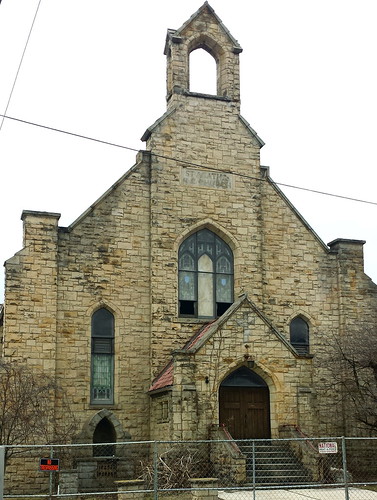
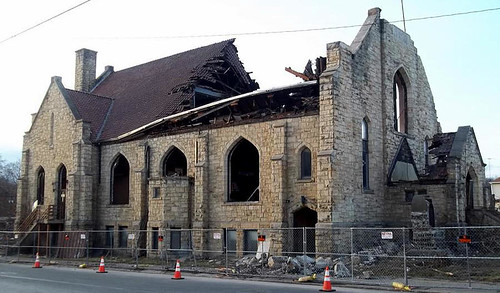
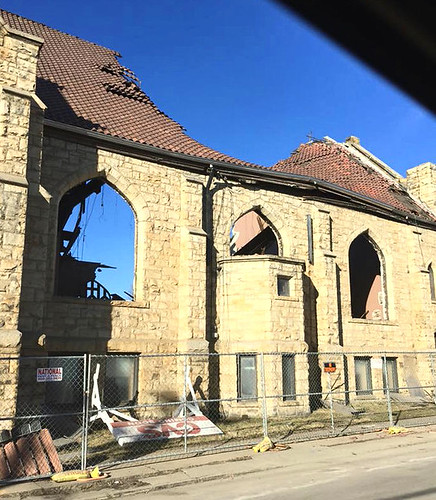

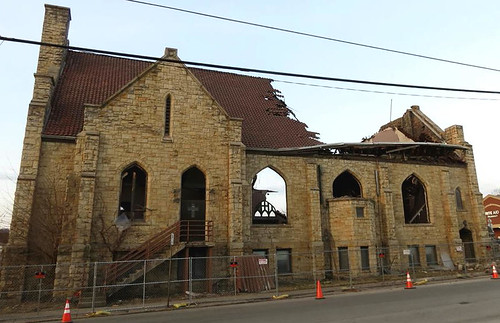
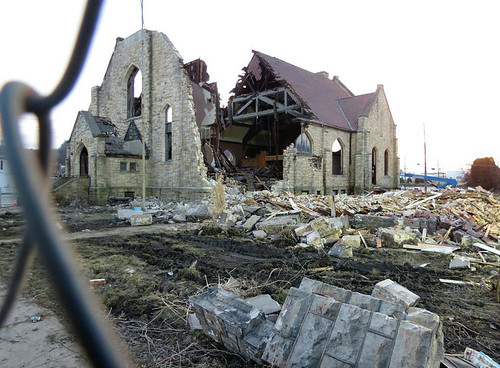
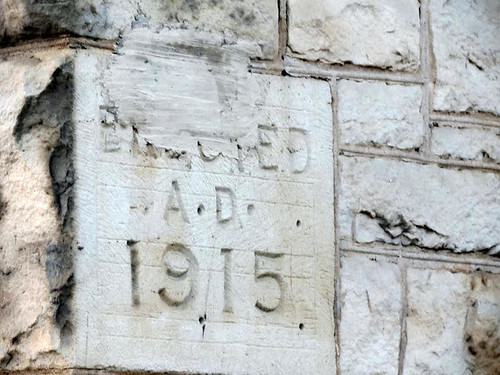
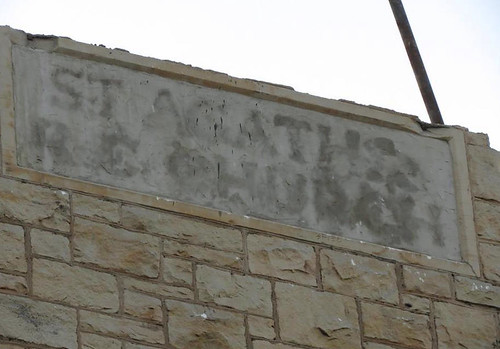
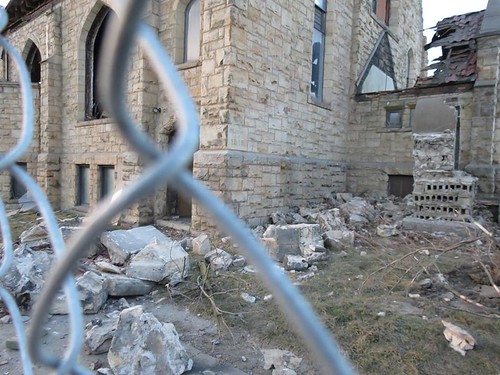

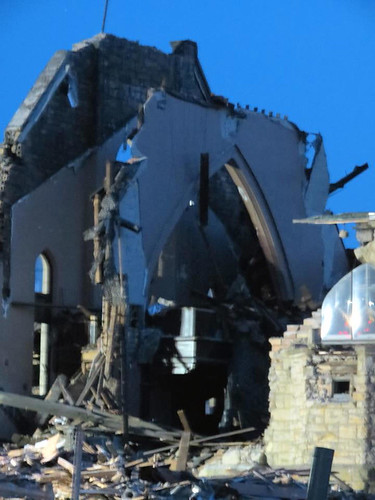
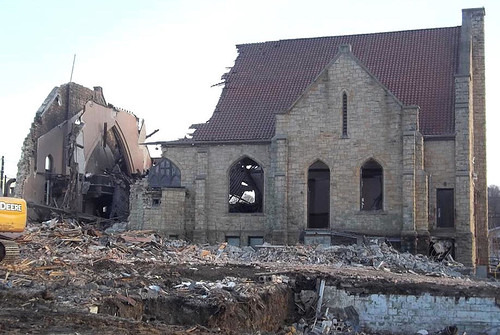
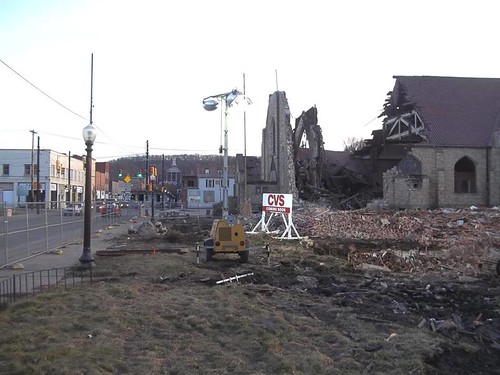
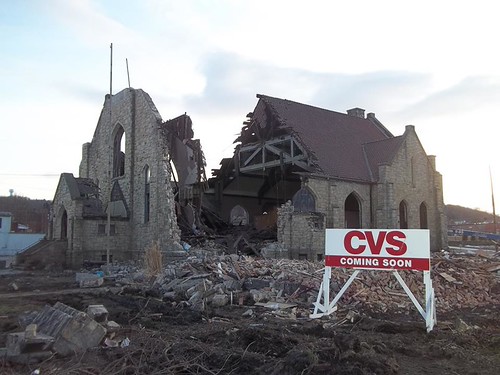
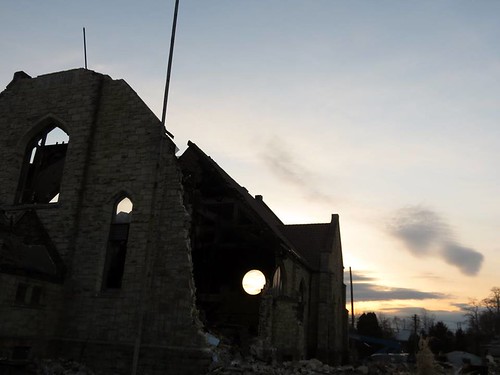



“Progress for progress sake”….. It’s very sad that when this building was sold the new owners were unable to complete their dream of salvaging this precious landmark. Thanks for the poignant article Susan. Well done!
Tisha,
First, thank you! That means a lot. We both know how precious this place was. I honestly feel like a Johnny-come-lately because I didn’t know that whole history, of the new owner trying to do something at the time. It is a shame that this didn’t happen. Others have converted former church buildings into excellent places.
It is a precious place!
Thanks so much.
Susan
Just saw the Salvage Dawgs episode about this church. I’m not Catholic (or even much of a Christian!). But destroying this church to make room for a CVS breaks my heart.
Hello!
I agree. It is heartbreaking…truly unconscionable. I haven’t been able to bring myself to watch the Salvage Dawgs episode about the church but will have to do so. Your writing about it reminds me to do so. It makes me think about the process of treasures from buildings living on.
Were you a member of the church? Thanks for sharing here!
Susan
Hello Susan,
I was not a member of this particular church. But I am a native of Pennsylvania who shares a deep respect and admiration for old buildings. Every time one is torn down, I feel like a part of my ancestry has been destroyed.
Companies like Salvage Dawgs do their best to preserve historical artifacts. But I feel like, with a little effort, most of the buildings that are razed to the ground could have been restored and converted for another purpose. Because, as we all know, modern buildings are not built to last.
Thanks for sharing your thoughts with me!
Anna
Bella e tragica
Sì, molto ben detto.
Susan, you know how I feel about St Agatha’s coming down. It is a real shame to think the church I was baptized in will no longer be there for all to see. I, too, wish there could have been something done to make it a historical building and CVS built past the church. Very sad to see it coming down in little bits. I would like to get a brick if possible.
Patti,
This part that you are speaking of, the connection to one’s own life and baptism, is so important. So many have written similar comments on the Ellwood City community page, and how many more feel this way? It really is tragic, I feel.
As for a stone, I had seen some comments from people on the Facebook page for Ellwood City, that they were able to get stones. I’m not sure how, but it would be worth a ride over to do it. Those stones are precious.
Susan
Thank you for doing this, Susan. Well-done.
Rita,
You’re welcome. The community has had such an outpouring of feelings that it felt important. I always try to learn from something like this for the future.
Gratefully,
Susan
With beautiful architecture like this bulldozed, our world is turning into one big, boring strip mall.
Thank you for sharing this sad and all-too-familiar story.
Colleen,
I have precisely this feeling at times. We’ve seen a couple of generations of too much highway-oriented bad, bland design happening, and this new pharmacy will be an example of it occurring just off the downtown. (In fact, more care needs to be taken as to what builders and designers bring to us off of the highways.) Even worse, it is at the cost of such a precious, one-of-a-kind place.
Thank you for your response to the article! I do believe that historic preservation efforts are trying to seek this balance so that places like St. Agatha’s are not lost for future generations. It is a tragedy that this one was.
Susan
As a Presbyterian growing up in Ellwood in the ’50s and ’60s who attended another stone church I now fear for, I was only in the St. Agatha sanctuary once. Used to our own church’s starkly beautiful interior of wooden buttresses and pews, stained glass windows, and a single empty gold cross, I found St. Agatha’s exotic and enticing. I remember wishing I could genuflect, cross myself, and take my troubles to the Virgin Mary in her grotto.
I had a devoutly Catholic friend whose family belonged to St. Agatha’s. Catholic John F. Kennedy’s election to the Presidency in 1960 was deeply meaningful to my friend and the day he was assassinated, she went directly to St. Agatha’s seeking comfort from the Mother who knew heartbreak so well. Today I cry for us both as a place of solace — hers in reality, mine in fantasy – is destroyed.
Jonnie,
Your writing about the meaning for you and that time period is so evocative and beautiful.
It touches on my own memories in Wampum, at St. Monica’s (now closed), where as a child I sat just to the side of the Good Shepherd statue and felt the protection of Jesus. Later, in my first years of college, I can recall going to the Protestant churches attended by my friends and loving their simplicity. They are different worlds, in some ways, but certainly ones in which we each could share, as your comment so well states.
I’m not sure, but do you mean Christ Presbyterian Church in Ellwood City? It is a lovely church, and historic. I did not know its exact history, but just poked around and found on the church’s site that the congregation dedicated its church in 1912. It is beautiful, very stately.
The congregation has invested recently to upgrade it for particular safety and accessibility measures, according to the Ledger (and you likely already know about this, for I’m posting it for other readers).
I wasn’t able to go deeply enough for this essay into the topic of historic preservation measures for the Borough of Ellwood City, as much as I would have liked. I’m very unfamiliar with the way it works in Pennsylvania towns, as opposed to New York City and State. Many towns, as you may well know, too, use historic landmark and district designations to balance the need for growth with preserving important places. It’s not an easy balance. However, IMO, towns that balance this well find that it fosters excellent development. I don’t know the situation in Ellwood City as much.
In any case, those are some of my thoughts at reading your very poignant posting.
Thank you, Jonnie!
Susan
And thank you, Susan, for writing a piece that overwhelmed me with memories. I haven’t lived in Ellwood since 1966 when I graduated from Lincoln so I don’t know what’s happening with my old church. (Yes, it was Christ Church). I took my husband back to Ellwood when we were first dating seriously and had him walk the streets, go to the pool, walk in the woods, and wade in the crick, hoping he’d see that to know me, he had to know my town. Much as I love where I now live, I am so grateful to have grown up in Ellwood and I cherish my upbringing, my lifelong friends, and every blessed tree, brick, and stone so lovingly laid.
Jonnie,
I LOVE your story of taking your husband back to Ellwood to know what was and is so important to you. I can well relate! It’s such a great capturing of your love for this special place in your heart and life!
Susan
I, like Jonnie, was raised Presbyterian. I rode the school bus past St Agatha every day. My best friend’s Dad was the janitor there, when we were kids. I think the demolishing of this Historic Monument of times past has been the shock that maybe we have needed to awaken this generation to the loss of not only this shrine but to the resurgence of historical appreciation in the community.
There needs to be growth and sometimes things need rebuilt, or preserved. And there’s nothing wrong with a revival of civic pride and people making renewed commitments to the things they hold dear. The old people built these edifices, the churches, Factories, and buildings because of their commitment. I would hope this latest episode sparks a movement to a deeper love for the history of this area.
I applaud Mark Barnes for all his efforts to share his love of local history on Facebook with us and how he has drawn out our innermost emotions with his pictures, books, and posts. And Susan, to so succinctly pen this article is such a blessing to us.
Jim,
Thank you for your excellent comment, full of a lot of insight. “Shock” is a right word, even though this was happening over a number of years. I even chastise myself for not knowing enough about it, though I don’t live in Western PA now. Still…
From your post to others’ and the Divine’s ears! Often, a particular event can be a catalyst to change and needed actions. You are right about owing something to the prior generations that created what we so fortunately inherited today, such as artworks and splendid, sacred buildings.
In New York City (and you may know this history), the demolition of the old, magnificent Pennsylvania Station in 1963, in large part, sparked action and the enactment of city Landmarks Preservation measures. It caused ripples of shock in New York.
Anyhow, that is just one example. Like you, I appreciate Mark Barnes posting the local history on Facebook, on the page I’ve only recently begun to participate in. I will keep up on what is happening there!
Thank you for sharing your memories, too – your comment is a blessing, Jim!
Susan
When I drive past St. Agatha I go back to those memories I have had going there as a young child. I think of the many prayers said there, worshiping our God there. I also have my mother and father’s wedding picture taken in front of the main doors standing on the steps with my aunt and uncle. So many memories fill my mind.
I was baptized in this church and went to Sunday School and did my first Communion in the church. Weddings, funerals, happy times, and yes, sad times. I understand that time goes on, but I feel that something has been ripped out of each and every one of us who attended the church.
Oliver,
“Ripped out” is so true. I’m grateful for you sharing your memories here, and in such a beautiful way. As you say, time goes on, but we as a society really have to be careful to tend such special places and memories, for those who have come before us and those who will come afterward.
Grateful for your reading the essay and responding with your own, very special thoughts!
Susan
Susan,
Thank you for a masterful article. Having gone to such depths in developing your story, you have succeeded in bringing forth the emotions and spiritual nature that the parishioners of St Agatha feel in this loss. It’s so hard to hear “It’s just stone, time to move on….” For many of us it was a tangible representation of our Faith and Spirituality. As you generations of memories were invested within these walls. Thank you for your understanding. Hopefully as we move forward other communities will be able to invest in their past and move into the future, because of your article.
Thanks again.
Mark,
Thank you so much for your very gracious response. The photos and comments that many graciously shared really supported the article’s telling. You so excellently state why the church was a “tangible representation” of faith and spirituality, particularly one over generations. So many find great comfort and inspiration in that year after year, its connective threads.
I’m grateful to you and others for the conversational exchanges at the Ellwood City community page, which sparked my desire to capture the strong emotions, some of the issues, and the sense of loss. My own sense of a need to “move on” (as some have said) is complex: People obviously have needed to express their feelings during this time, particularly at seeing – – talk about tangible – the building come down before them. Still, it’s worth considering what happened to learn from it for the future, in this town and elsewhere, as you are saying.
Thank you again, Mark!
Susan
I am a converted Catholic and always loved the serenity of the Mass. I finally found a church that made me feel the power and love of God; that church was St. Agatha! It was old but beautiful and calming. I will miss its stately appearance when I pass by where it formerly stood, proud and strong. Thanks, Vicki
Vicki,
Thank you for your wonderful memory, which paints such a true picture of the beauty and tranquil spirit found at St. Agatha’s.
Gratefully,
Susan
Dear Susan,
Brother Thom shared your article with me this morning via email….beautiful, absolutely beautiful. I’m sure Thom shared with you the story of our grandfather (Joseph DeTullio), whose gifted hands as a stonemason helped create the grotto. Broke my heart to see it destroyed. Thanks for your time spent writing such a moving article.
Dear Bethann,
Yes, it is heartbreaking for such a gift as your and Thom’s grandfather created, for St. Agatha’s, to be destroyed. I still shudder at it. Consider how many people over the years found peace near that grotto. Thom’s writing about the grotto, the excerpt I was able to include, was amazing – one could just see your grandfather so vividly and his hands working with the limestone. I’m looking forward to getting a full copy of his article, “The Gift of Stone.”
I’m very grateful for your note, Bethann, and my thoughts are with you and your family over this happening. It’s so important that Thom memorialized Grandfather DeTullio’s gift as a stonemason in his writing.
Thank you again.
Susan
Dear Susan,
Thank you for the beautifully written article about my church, St. Agatha. I, along with my four siblings, grew up in that church. My mother was a Christian Mother and my dad, Knights of Columbus. I have many pictures of myself in front of the grotto; First Communion, Confirmation, Graduation; and everything in between. My religious memories are gently intertwined with all the social events I attended in the basement of the church. The church was at the center of our lives, both socially and spiritually. My heart is broken that all those memories are now in a pile of rubble.
Today, I live in Chapel Hill, N.C., and belong to a large, active, and wonderful church. The church building is new and perfectly suited to handle the large congregation of nearly 2,500 families. But little St. Agatha was intimate, old-fashioned, and beautiful with its white marbled altar, stained glass windows, and an old world charm. I mourn the loss of a precious piece of my past.
Margy,
Thank you (and how good to hear from you!). Yours is such a poignant, gentle remembrance. It makes so clear how rooted your family life was in this wonderful, intimate church, and how those roots have proven so strong in your spiritual life now, in Chapel Hill. I can picture the peacefulness of St. Agatha’s in the picture you draw here. This church has been such a blessing in people’s lives.
It is a heartbreaking loss to so many, like you. I sought to honor that in this essay, through people’s own words and pictures. Thank you for sharing your remembrance, too, which is precious, as St. Agatha’s was to so many.
Gratefully,
Susan
Well-done, Susan, a great tribute, from someone so close to home…..we all thank you for the time and energy you have put into your blog. Yes, a structure, the art of a time, is gone, the craftsmen’ sweat and love went into the work of art, and now you have converted it to words, and love, with the understanding of what it meant to the people.
There is still the pointing of fingers, on why, but there is one thing we all can say is, it’s gone……and like a life, we must deal with it……history will judge.
Frank,
Thank you so much. I felt that I wanted to honor that very sacred, holy, historical place, and even more, the memories and love of the church by so many. I was also moved by the photos that people were taking as the crew took down St. Agatha’s.
You said it very eloquently, Frank, about the art, the craftsmen’ sweat and love, and the building itself. You are so right that “history will judge.”
Blessings and gratitude to you!
Susan
Below is a link to a video of the intact St. Agatha, captured on the day of the last wedding performed there.
https://vimeo.com/158982372
Raylene,
Thank you so much for sharing the video here. It’s very exquisite and lovingly done, with the beautiful music as well. Each scene captures the beauty and spiritual peace of St. Agatha’s. Makes it all the more hard to believe this place is gone, though not the spirituality that lives on in its parishioners.
I’m so grateful that you shared the link. It also makes me think of all of the couples who exchanged their sacred vows through the many decades.
I know I will watch it again quite a few times, as will others, I imagine!
Thanks, and blessings!
Susan
What a shame to tear down a century-old building built by stonemasons and quality craftsmen. The building could have easily stood another 100 years the way it was constructed. Where did the furnishings, mass service items, and other precious artifacts of religious significance go?
John,
Yes, the loss of a structure like this church building is egregious. You are so right that the beautiful, solid, and exquisitely crafted building could have stood another century, to be sure!
Writers in the local press wrote articles about what was happening with the precious artifacts and other components of the interior. In sum, artifacts were salvaged for sale or scattered in unknown ways. Around the time that CVS purchased the property and building, in order to raze it and construct a pharmacy, the local Ellwood City Area Historical Society made efforts to determine and, perhaps, obtain some artifacts. However, the society’s officers said at the time that CVS did not respond, according to an Ellwood City Ledger article on March 2, 2016. A CVS official told the newspaper that anyone who wanted to inquire about artifacts could contact the CVS corporate developer. Still, the historical society’s efforts apparently were for naught, from what I can tell.
In addition, Black Dog Salvage, a Roanoke, Va.-based architectural salvage business, came to Ellwood City early in 2016 to salvage stained glass windows and other items, the Ellwood City Ledger reported in another article on Feb. 11, 2016. The plan then was for the firm to market the items online.
I’m going to dig a little further to see if I can find out more about the artifacts and other items. Talk about sad! As you say, these are precious!
Susan